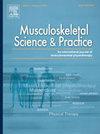What factors influence the community's use of physiotherapy services as first-line management for temporomandibular disorders? A qualitative study using the COM-B framework
IF 2.2
3区 医学
Q1 REHABILITATION
引用次数: 0
Abstract
Background
Physiotherapists play a unique role within the multidisciplinary management team for temporomandibular disorders (TMDs). However, historically they have been under-recognised and under-utilised in the care of individuals with TMD. To improve TMD management pathways and facilitate uptake of subsequent physiotherapy services, it is important to understand factors which underpin care-seeking behaviours of individuals with TMD in the community.
Objectives
To understand 1) what individuals with TMD perceive the role of physiotherapy to be in TMD management, 2) how these perceptions influence individuals' behaviour in seeking and receiving TMD care, 3) what other factors influence individuals’ behaviour in seeking and receiving TMD care from a physiotherapist.
Design
Qualitative, grounded in a relativist ontological and constructionist epistemological approach.
Method
Fourteen individuals with TMD (mean age = 37 years) were purposively recruited and interviewed using a semi-structured framework. Data were analysed deductively using the COM-B framework via a reflexive thematic analysis approach.
Results
Data were encapsulated into three themes: 1) motivation, 2) capability and 3) opportunity. Discord between participants’ perceptions about TMD and the role of physiotherapists was frequently observed, alongside challenges accessing physiotherapy services due to physical opportunity (e.g. time, financial, geographical, technological) and social opportunity (e.g. connections with and of healthcare practitioners) factors.
Conclusion
Various intrinsic and extrinsic factors influence individuals’ utilisation of physiotherapy services for TMD, including their knowledge about the condition and physiotherapy services available, their social connections, physical opportunity and their motivation to seek help. Promotion of physiotherapy services for TMD should consider these factors to optimise patient care.
什么因素影响社区使用物理治疗服务作为颞下颌疾病的一线治疗?使用COM-B框架的定性研究
背景物理治疗师在颞下颌疾病(TMDs)的多学科管理团队中发挥着独特的作用。然而,从历史上看,它们在TMD患者的护理中没有得到充分的认识和利用。为了改善TMD管理途径和促进后续物理治疗服务的吸收,了解社区中TMD患者寻求护理行为的因素是很重要的。目的了解1)TMD患者对物理治疗在TMD管理中的作用的认知,2)这些认知如何影响个体寻求和接受TMD护理的行为,3)哪些其他因素影响个体寻求和接受物理治疗师的TMD护理的行为。设计定性,以相对主义本体论和建构主义认识论方法为基础。方法有目的地招募14名TMD患者(平均年龄37岁),采用半结构化框架进行访谈。通过反身性主题分析方法,使用COM-B框架对数据进行演绎分析。结果数据被归纳为三个主题:1)动机,2)能力,3)机会。参与者对TMD的看法与物理治疗师的作用之间的不一致经常被观察到,此外,由于物理机会(如时间、财务、地理、技术)和社会机会(如与卫生保健从业人员的联系)等因素,在获得物理治疗服务方面存在挑战。结论多种内在和外在因素影响个体对TMD物理治疗服务的利用,包括他们对病情和可获得的物理治疗服务的了解、他们的社会关系、物理机会和他们寻求帮助的动机。推广TMD物理治疗服务应考虑这些因素,以优化患者护理。
本文章由计算机程序翻译,如有差异,请以英文原文为准。
求助全文
约1分钟内获得全文
求助全文
来源期刊

Musculoskeletal Science and Practice
Health Professions-Physical Therapy, Sports Therapy and Rehabilitation
CiteScore
4.10
自引率
8.70%
发文量
152
审稿时长
48 days
期刊介绍:
Musculoskeletal Science & Practice, international journal of musculoskeletal physiotherapy, is a peer-reviewed international journal (previously Manual Therapy), publishing high quality original research, review and Masterclass articles that contribute to improving the clinical understanding of appropriate care processes for musculoskeletal disorders. The journal publishes articles that influence or add to the body of evidence on diagnostic and therapeutic processes, patient centered care, guidelines for musculoskeletal therapeutics and theoretical models that support developments in assessment, diagnosis, clinical reasoning and interventions.
 求助内容:
求助内容: 应助结果提醒方式:
应助结果提醒方式:


